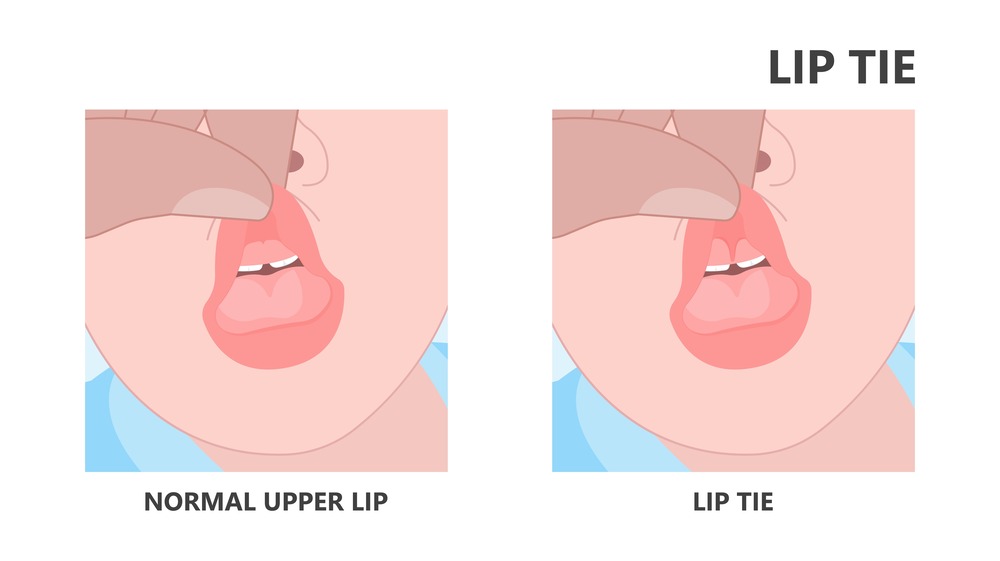A lip tie happens when the tissue that connects your child’s upper lip (the maxillary labial frenulum) to their gums is too tight or thick. This tissue is called the maxillary labial frenulum.
In some babies and young children, the frenulum doesn’t stretch or move easily, which can limit the lip’s range of motion. This can make simple things like nursing or brushing teeth more difficult.
Lip ties can vary in how noticeable or restrictive they are. Some children have a visible band of tissue but no problems with eating, speech, or oral hygiene. Others might struggle with feeding, which can lead to slow weight gain or frustration at mealtimes. A lip tie is often spotted during early infancy, especially if breastfeeding is difficult, but it can also be diagnosed later in childhood if it starts to cause problems.
A lip tie is not the same as a tongue tie, although they can appear together. If you are looking for information on tongue ties, we have a complete guide to tongue ties as well.
Symptoms of a Lip Tie
Lip tie symptoms often show up during feeding or brushing routines. You might notice signs in your baby, toddler, or even preschooler. These symptoms can vary depending on the child’s age and the tightness of the frenulum.
Some common signs in babies include:
- Difficulty latching during breastfeeding
- Clicking sounds while feeding
- Long feeding sessions or frequent breaks
- Poor weight gain
In toddlers and older children, you might see:
- Food getting stuck in the upper front teeth
- A gap between the upper front teeth
- Trouble brushing the upper gums
- Tooth decay in the upper front teeth due to poor cleaning
Feeding issues are often the first sign parents notice. If your baby seems uncomfortable, gassy, or frustrated during nursing, a tight lip frenulum might be the reason.
As children grow, dental problems or speech issues might appear if the tie limits lip movement or causes discomfort. Recognizing these signs early can help you decide when to speak with a professional.
What Issues Can a Lip Tie Cause
A lip tie can create challenges with feeding, speech, oral hygiene, and even dental development as your child grows. When the upper lip cannot move freely, it affects how babies latch during breastfeeding and how older children use their lips for eating and speaking.
In infants, feeding problems are the most common issue linked to a lip tie. Babies may have difficulty forming a good seal, which can lead to:
- Poor milk transfer
- Short, frequent feedings
- Long feeding sessions that still leave the baby hungry
- Gassiness from swallowing air
- Fussiness during or after feeding
As children grow, a tight frenulum can interfere with other parts of daily life. Some children with a lip tie may:
- Have a noticeable gap between their two upper front teeth
- Struggle to clean their upper front teeth properly
- Experience speech delays or articulation problems
- Avoid certain foods that are hard to chew or require lip movement
If a lip tie is not addressed early, these issues can continue into school age. This can lead to frustration for the child and more complicated treatment later. Not every lip tie causes problems, but if your child has symptoms, it’s worth getting an evaluation.
How Do You Diagnose a Lip Tie?
Diagnosing a lip tie involves more than just looking inside your child’s mouth. While you may see a piece of tissue between the upper lip and gums, only a trained professional can tell if it’s causing a problem. The diagnosis depends on how tight the tissue is and whether it limits lip movement enough to affect feeding, speech, or oral hygiene.
A full assessment looks at how your child eats, speaks, and uses their lips in everyday activities. Health care providers also check for related symptoms like difficulty latching, gas, or slow weight gain. In many cases, a team approach works best, where a pediatric dentist, lactation consultant, or speech therapist may each offer input.
Getting the right diagnosis helps you decide what to do next. Some lip ties don’t need treatment, but others can lead to long-term feeding and dental issues if left alone.
Don’t Diagnose at Home
Trying to diagnose a lip tie on your own can be misleading and stressful. Even if you see a piece of tissue under your child’s lip, you won’t know if it’s tight enough to cause trouble just by looking. Online photos and checklists often oversimplify what’s actually a complex issue.
Many parents worry when feeding problems show up, but not all of them are caused by lip ties. That’s why it’s important to get a professional opinion instead of guessing. It can save you time, reduce worry, and make sure your child gets the help they need—if they need it.
Get an Assessment from a Pediatric Dentist
A pediatric dentist is trained to assess lip ties and understands how they affect both feeding and long-term oral development. They can check how far the frenulum extends, how much it restricts movement, and whether it’s likely to cause problems. You’ll get a clear explanation of what’s going on and what options you have.
Should You Treat Your Child’s Lip Tie?
Deciding whether to treat a lip tie depends on how much it affects your child’s daily life. Not all lip ties need treatment, especially if feeding, speech, and oral hygiene are going well. If your child has no symptoms or only mild ones, you can often take a wait-and-see approach.
On the other hand, if your child struggles with feeding, is not gaining weight, or has trouble brushing their teeth, treatment may help. A proper assessment from a pediatric dentist or lactation consultant will guide the decision. Treatment is most useful when it solves a clear problem, not just when a lip tie is visible.
Once you understand how the lip tie affects your child, you and your care team can decide on the next steps together.
Start with Non-Surgical Treatments First
We typically recommend that parents start with monitoring and non-surgical treatments first. If your child has a lip tie and is showing symptoms, there are treatments that support feeding and oral function without going to surgery. Many children improve with simple, non-invasive support.
Treatments to consider include:
- A lactation consultant can help improve latch and feeding position.
- A bodyworker such as a chiropractor or osteopath can reduce tension in your baby’s head and neck.
- A myofunctional therapist can give exercises for lip strength and mobility in older children.
These approaches often help enough that surgery isn’t needed. Working with professionals who understand infant feeding and development makes a big difference.
Surgical Release with a Frenectomy
If non-surgical treatments don’t help or your child has severe symptoms, a minor procedure called a frenectomy may be recommended. A frenectomy releases the tight tissue under the lip so it can move more freely. This can improve latching, reduce feeding pain, and support normal oral development.
Pediatric dentists usually perform the procedure in-office using a laser or small surgical tool. At Kids Dental Group, we use a laser for lip ties.
The process is quick, and babies can breastfeed right away after the release. Aftercare consists of stretches to prevent reattachment as the area heals.
Surgery isn’t always necessary, but it can make a big difference when a lip tie causes real problems. Your care team will help you decide if it’s the right choice.
Kids Dental Group Can Help
If you’re feeling unsure about your child’s lip tie or wondering whether treatment is needed, Kids Dental Group is here to support you. Our team understands how overwhelming feeding challenges or oral concerns can feel, especially in the early years. You don’t have to figure it out on your own—we’re here to answer your questions and guide you every step of the way.
Our pediatric dentists have experience assessing and treating lip ties in infants and young children. We’ll take the time to explain what we see, what it means, and what options make sense for your child. Whether it’s a simple check-up or a complete care plan, we’re here to help you make informed decisions.
Book an Appointment with Us Today

